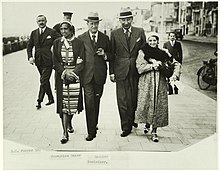|
Fritz Mannheimer
Fritz Mannheimer (19 September 1890 – 9 August 1939) was a German-born and, from 1936, Dutch banker and art collector who was the director of the Amsterdam branch of the Berlin-based investment bank Mendelssohn & Co. that was for some time the main supporter of the Dutch capital market. Known as the "King of Flying Capital", he was one of the main organisers of credit for post-war Germany. His international financial work brought him recognition, such as being awarded Grand Officer of the Légion d'honneur. His collection was bought by Hitler in 1941, but it was returned to the Netherlands after the war. Birth and youthBorn into a Jewish family[1] in Stuttgart, Württemberg, he was a son of Max Mannheimer, a wine merchant, and his wife, Lili Sara Fränkel. He attended the University of Heidelberg where he obtained a Doctor of Law and became a Dutch citizen in 1936. Career and lifestyleAccording to an obituary of the banker published in the 21 August 1939 edition of Time:
In fact, Mendelssohn & Co. Amsterdam was independent of the Berlin Mendelssohn bank. As such it helped the German industrialist Robert Bosch to establish an American firm, thus circumventing the rules against German capital in the U.S.A. [3] The Time profile, while acknowledging Mannheimer's power and position, was also remarkably negative, describing him as "fat-lipped, mean, noxious, cigar-chomping"[2] man who gave one of his mistresses a gold bathtub and who, "after 20 years in The Netherlands, could not speak enough Dutch to boss his chauffeur."[2] Another source recalled that while most Amsterdam bankers were discreet enough to use taxis for daily transportation, the flamboyant Mannheimer traveled by a Rolls-Royce limousine. He also raised eyebrows by maintaining two lavish homes: a 1913 redbrick mansion at Hobbemastraat 20 in Amsterdam, which was derogatorily nicknamed "Villa Protski", and Villa Monte Cristo near Vaucresson, France. His offices were located in a palatial 17th-century mansion in Amsterdam, at Herengracht 412. Marriage and childAt his home in Vaucresson, on 1 June 1939, Mannheimer married Marie Jane Reiss (1917–2004). Born in China, she was one of three daughters born to Hugo Reiss, a prominent German Jewish businessman in Shanghai who served as Brazil's consul in that city, and his American-born Irish Catholic wife, Marie Ignatius Murphy.[4] According to the Time profile, Mannheimer, who had long been obese and in ill health, suffered a heart attack during the wedding and had to be revived with two injections. The best man was Paul Reynaud, the French minister of finance and later French prime minister; the banker also was a close friend of prime minister Édouard Daladier. The couple had one child, Anne France Mannheimer, later known as Anne France Engelhard. She was born on 24 December 1939, six months after her parents' marriage and four months after her father's death. (Commonly called Annette, she later became the second wife of the Dominican-American fashion designer Oscar de la Renta.) DeathOn 9 August 1939, two months after his wedding, Mannheimer reportedly was in his Amsterdam office when he received a phone call from an unidentified party, left the office, boarded a train for France, and joined his wife at their house, where he died the same day. Contemporary observers quickly speculated on the manner of death, with many newspapers suggesting suicide; but Mannheimer's health had always been precarious, due, in part, to his excessive weight. In addition to the heart attack suffered on his wedding day, he reportedly nearly died after suffering another, while travelling in Egypt, in 1937. Shortly before his death, Mannheimer, who stood 172 centimetres (5 ft 8 in) tall, was described as being "half his normal weight" of 90 kg (200 lb). Whatever the actual cause of death, The New York Times was just one of many leading world newspapers which reported that Mannheimer's demise took place under "circumstances attended by a measure of mystery." The day after his death, Mendelssohn & Co. in Amsterdam announced that it was insolvent and that Mannheimer's collections, which were valued at more than 13 million guilders (approximately $100,000,000 today), had been largely funded on unlimited bank credit. Housed at his homes in the Netherlands and France, Mannheimer's art (which included works by Chardin, Fragonard, Watteau, and Rubens, at least one fake Vermeer,[5] gold reliquary busts, tapestries, Meissen porcelain, and Judaica including a naturalistic circa-1800 Hanukkah lamp known as the "Oak Tree Menorah"), and his collection of 18th-century furniture (much of it acquired for him by the American decorator Elsie de Wolfe and the Paris decorator Stéphane Boudin) were seized by the bank. As a history of Mendelssohn & Co. states, "the Amsterdam branch had to suspend its activities due to false speculations on the part of its director."[This quote needs a citation] Demise of bank, dispersal of art collectionThe entire Mendelssohn firm was forcibly liquidated by the Nazis later that same year—its assets were transferred to Deutsche Bank—and much of Mannheimer's art was purchased by Adolf Hitler in 1941, after the German invasion of the Netherlands.[6] Other works from the collections were stored in England and Vichy, France, by Mannheimer's widow until the end of the war. The lion's share of Mannheimer's collection was acquired by the Rijksmuseum in 1952, when it was repatriated from Germany; the museum was forced to sell half of the collection by the order of the Dutch Ministry of Finance. Coincidentally, Mannheimer's Amsterdam residence now is used for some of the Rijksmuseum's offices. The Metropolitan Museum of Art owns one of the masterpieces of Mannheimer's collection, "Young Man Blowing Bubbles" (a.k.a. "Soap Bubbles"), a circa-1734 painting by Jean-Baptiste-Siméon Chardin; it was sold in 1949 to the museum by Wildenstein & Co., the art dealers, who had acquired the painting after it was repatriated to France in 1946. Notes
References
External links
|
||||||||||||||||||||||
Portal di Ensiklopedia Dunia
